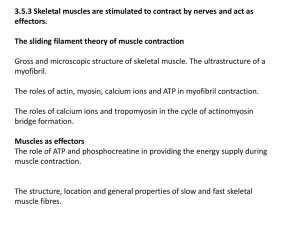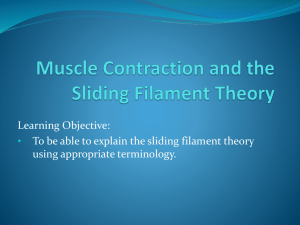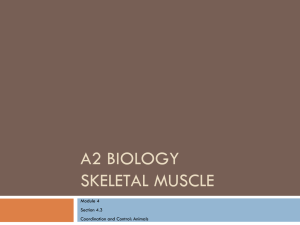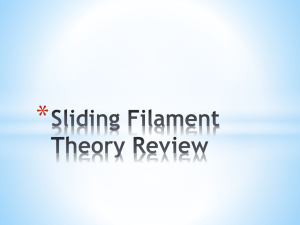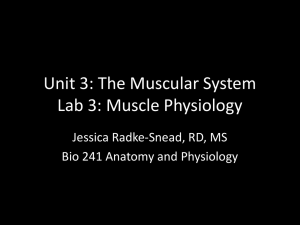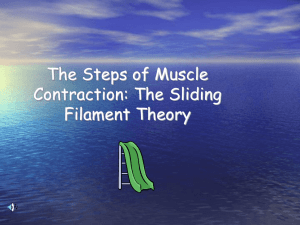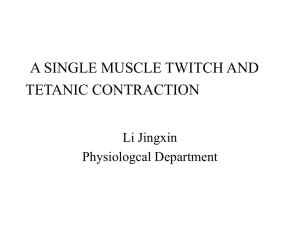click - Uplift Education
advertisement
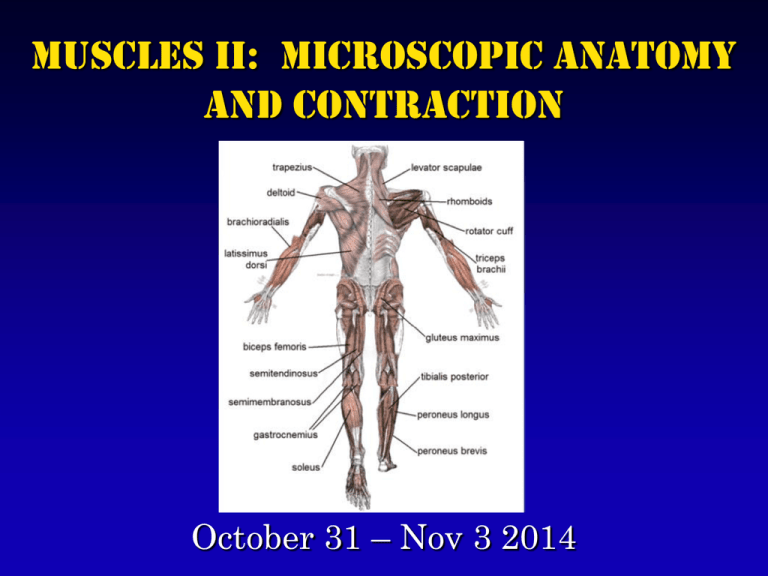
Muscles II: Microscopic Anatomy and Contraction October 31 – Nov 3 2014 Muscle Structure Muscle Fascicle (bundle of fibers) Muscle Fiber (single cell) Myofibril Sarcomere (unit of contraction) Microscopic Anatomy of Skeletal Muscle • Large, cylindrical, multinucleate cells • Contain many mitochondria; nearly filled with myofibrils • Some organelles have unique vocabulary: – Sarcolemma: cell membrane – Sarcoplasm: cytoplasm – Sarcoplasmic reticulum: modified ER, surrounds each myofibril; store Ca2+ Microscopic Anatomy of Skeletal Muscle • Each myofibril can be divided into contractile units called sarcomeres. • Sarcomeres consist of overlapping protein filaments of actin and myosin. • Regular arrangement of dark and light bands. Dark bands occur where myosin is present. Microscopic Anatomy of Skeletal Muscle • The M line is where the myosin attaches • Z discs (a membrane) mark the edge of each sarcomere; serve as attachment site for actin Microscopic Anatomy of Skeletal Muscle Use the picture to come up with a definition of the following: I band A band H zone Microscopic Anatomy of Skeletal Muscle Use the picture to come up with a definition of the following: I band – area without myosin fibers; aka light band A band – area with myosin fibers; aka dark band H zone – area without actin fibers Turn & Talk First match the words … actin cell myofibril group of cells sarcomere cell membrane fascicle protein muscle fiber organelle sarcolemma contractile unit Then, write a paragraph that uses all the words in both columns above and explains that structure of the muscle. Contraction Overview • Globular heads of myosin filaments attach to actin filaments. • Myosin pulls actin filaments : “Sliding filament theory” • Causes sarcomere to shorten, particularly the light bands Contraction Overview • Globular heads of myosin filaments attach to actin filaments. • Myosin pulls actin filaments : “Sliding filament theory” • Causes sarcomere to shorten, particularly the light bands light dark light dark light light Contraction Overview Which shows contracted muscle fibers? How can you tell? Contraction Overview Relaxed muscle (large light bands) Contracted muscle (small light bands) Contraction Overview What are these? See animation! Mitochondria Contraction Details 1. A motor neuron stimulates the muscle cell by releasing the neurotransmitter acetylcholine ACh into the synaptic cleft between the neuron and muscle cell. Note: A motor unit is a single motor neuron and all the muscle fibers it activates Contraction Details 1. A motor neuron stimulates the muscle cell by releasing the neurotransmitter acetylcholine ACh into the synaptic cleft between the neuron and muscle cell. 2. ACh causes an electric current called an action potential to move through the muscle cell. Contraction Details 1. A motor neuron stimulates the muscle cell by releasing the neurotransmitter acetylcholine ACh into the synaptic cleft between the neuron and muscle cell. 2. ACh causes an electric current called an action potential to move through the muscle cell. 3. The action potential causes the release of Ca2+ from the sarcoplasmic reticulum. Contraction Details 4. Ca2+ exposes myosin-binding sites on actin filaments. 5. Myosin heads (& ADP) attach to actin binding sites, forming cross-bridges. actin ADP + P myosin head myosin Muscle relaxed. No Ca2+ present. Ca2+ present. Cross-bridge formed. Contraction Details 6. Myosin heads release ADP, move the actin filament in “power stroke” actin myosin Power stroke, ADP + P released Contraction Details 6. Myosin heads release ADP, move the actin filament in “power stroke” 7. ATP binds to myosin head. The crosslink between actin and myosin breaks. 8. ATP becomes ADP + P, readying the myosin head to reattach to actin. actin myosin Power stroke, ADP + P released ATP binds, cross-links break Contraction Details • If Ca2+ is still present, cycle will repeat, with myosin heads reattaching and contracting the muscle even more. • Once the action potential is over, the Ca2+ is reabsorbed into the sarcoplasmic reticulum. Without Ca2+, myosin cannot attach to actin. Watch me! Contraction Details NOTE: ATP is required to break cross-links, not to form them. Explains rigor mortis Why then do muscles need ATP? To reset head so it can contract further -contraction is a series of sliding motions. Turn & Talk Describe the role of each of the following in muscle contraction Scholar with more siblings…. • ACh • Ca2+ Scholar with less siblings … • ATP • Action potential Exit Ticket 1. In comparing electron micrographs of a relaxed skeletal muscle fiber and a fully contracted muscle fiber, which would be seen only in the relaxed fiber? a) b) c) d) e) Z discs Triads I bands A bands H zones Exit Ticket 2. Which word describes the unit of contraction of a muscle? a) b) c) d) Myofibril Sarcomere A band H band Exit Ticket 3. Which of the following correctly lists the order of structure of the muscle from largest to smallest? a) b) c) d) fascicle, myofibril, sarcomere, muscle fiber myofibril, fascicle, sarcomere, muscle fiber fascicle, muscle fiber, myofibril, sarcomere muscle fiber, fascicle, myofibril, sarcomere Exit Ticket 4. Which of these stores calcium ion? a) b) c) d) Sarcoplasmic reticulum Sarcomere Sarcolemma mitochondria Exit Ticket 5. Which of these best describe the process of muscle contraction? a) b) c) d) The actin filaments shorten The myosin filaments shorten The light bands shorten The dark bands shorten Exit Ticket 6. Which of these best describe the process of muscle contraction? a) Myosin heads attach to actin filaments that are exposed by the presence of ATP b) Myosin heads attach to actin filaments that are exposed by the presence of Ca2+ c) Actin heads attach to myosin filaments that are exposed by the presence of ATP d) Actin heads attach to myosin filaments that are exposed by the presence of Ca2+

